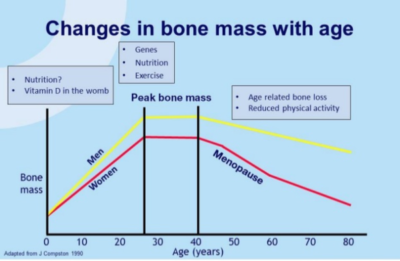Share

Osteoporosis literally means porous bones. When the bones become thinner, they become more fragile resulting in a higher risk of fracture.
Normal Bone
The skeleton is constantly changing, and the components of bone is replaced and rebuilt in order to adapt to the stress of living. Each bone is completely remodelled over a period of 12 months.
The effect of age and illness on normal bone
 As we age there is a decline in bone strength and the greatest risk for an osteoporotic fracture is increasing age.
As we age there is a decline in bone strength and the greatest risk for an osteoporotic fracture is increasing age.
Any illness that contributes to increasing the rate of ageing leads to an increase in the rate of osteoporosis and the risk of a fracture.
A common factor in all ageing diseases is inflammation. These diseases include
- autoimmune diseases eg rheumatoid arthritis.
- neurodegenerative diseases eg Parkinson’s Disease
- diabetes
- cancer
Other causes for accelerated osteoporosis
Lifestyle factors
Lack of exercise throughout life. 15% of bone strength is related to muscle mass. The more muscle the better.
Nutritional deficiencies such as low calcium intake. 5% of bone strength is due to nutrition.
Low vitamin D leads to poor absorption of calcium
Smoking
Low body weight.
Genetics
Bone strength is dependent on bone size. 80% of bone strength is genetic.
Hormones
Low oestrogen in women and low testosterone in men can cause osteoporosis
Medications
The most common ones are:
corticosteroids
antiseizure medications
aromatase inhibitors
Fractures
 A fracture leads to a profound negative impact on the quality of life, health span and lifespan.
A fracture leads to a profound negative impact on the quality of life, health span and lifespan.
An osteoporotic fracture is a life-changing event. This fact is very relevant when weighing up the benefits and risks of any therapy.
Most of the vertebral fractures are asymptomatic and therefore under-diagnosed.
A fracture leads to a profound negative impact on the quality of life, health span and lifespan. An osteoporotic fracture is a life-changing event. This fact is very relevant when weighing up the benefits and risks of any therapy.
One person in 5 will have one or more osteoporotic vertebral fracture after the age of 50. Most of the vertebral fractures are asymptomatic and therefore under-diagnosed.
Preventing a fracture is the best solution and the goal in managing osteoporosis.
How to determine the risk of a fracture?
If a patient has a decreased bone mineral density and/or risk factors for rapid bone loss, the bone mineral density should be monitored annually. Examples of risk factors include
A perimenopausal state
Use of glucocorticoids
Use of aromatase inhibitors
Low body weight
Malabsorption.
For any given bone density as measured by a DEXA Scan, the “t- score”, which is an estimate of the risk of fracture increases with advancing age and risk factors.
The articles below are designed to increase awareness and knowledge of osteoporosis so that appropriate treatment is initiated in those with the highest risk for fracture. The primary aim is to prevent a fracture.
Read more articles here :
- Osteoporosis is responsible for millions of fractures each year – the facts
- I am concerned about osteoporosis, what do I need to know.
- A Squat A Day Keeps Osteoporosis Away
- More Exercise = Fewer Falls
- Vitamin D and Osteoporosis plus a calcium intake calculator
- Hip Fracture risk increased by gastric acid blocking medications
- Exercise for Bone Health
- If you have to take prednisolone..
- The DEXA scan, measuring bone density
